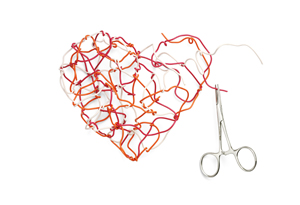
Photo: Plamen Petkov
Stem cells may soon allow doctors to turn back the clock on damage caused by heart disease.
Long before we feel a thumping beat in our chest, there is a moment when our heart first begins to take shape. At that point, it's hardly fair to call it a heart—it's just a speck-sized clump of cells without a pulse. But like a house being raised brick by brick, that clump, infused with cardiac stem cells—protean cells that are able to take the form of any heart tissue—expands into an elaborate structure. Some cells become muscle, aligning into four separate chambers. Others become valves and arteries, weaving intricately through muscle walls. With architectural precision, every kind of cell falls neatly into place. Not long afterward, the stem cells that built the heart dwindle until they almost disappear. And later—decades after the builders have gone—the house itself begins to fall apart. Arteries clog with plaque, plaque causes heart attacks, heart attacks destroy ventricular muscle. In the worst cases, the damage is so great that the only option is a transplant.
Over the next decade, though, many stem cell researchers believe, doctors will be able to restore even "irreversibly" damaged hearts, at least in part. "The ability to replace dead heart muscle with new lab-grown muscle after a heart attack is one of the great goals in medicine today," says Deepak Srivastava, MD, director of the Gladstone Institute of Cardiovascular Disease in San Francisco. If scientists can manage to do so, it would be monumental. Cardiovascular disease affects an estimated 81 million Americans and is the leading cause of death for both women and men in the United States.
The leap forward has been driven by a series of startling breakthroughs. Among the most radical was the discovery, in 2007, of a way to transform ordinary human adult skin cells back into stem cells (known as induced pluripotent stem cells, or IPS cells), by manipulating a small piece of the genetic code. IPS cells can be chemically prodded to become almost any tissue, including bone, cartilage, or heart. And they neatly sidestep the political and ethical morass surrounding embryonic stem cells—which, unlike IPS cells, must be derived from human embryos left over from fertility treatments.
How this could open the door to new heart treatments
The IPS discovery opens the door to a slew of potential heart treatments. According to Srivastava, the most exciting of these are heart "patches"—newly minted heart cells, yoked together on a lab-constructed scaffolding, that could be grafted onto the heart to offset damage after a heart attack. "There's tremendous potential to use stem cells to construct individual parts from scratch, whether it's a valve or a vessel or even a whole chamber," Srivastava says. Eventually, IPS technology could even be used to create entire transplant-ready hearts, though that level of engineering is likely at least 20 years away. "Creation of an entire heart from a patient's own cells will represent the ultimate in personalized medicine," Srivastava says. "The replacement organ will be genetically identical to the patient and will not suffer the risk of rejection, and patients will no longer have to die waiting for an organ donor."
Kenneth Chien, MD, PhD, director of the Cardiovascular Research Center at Massachusetts General Hospital and a professor of stem cell and regenerative biology at Harvard University, is leading one of several global heart patch research efforts. He believes that clinical work on a patch could begin within five years—though he notes that the first studies are likely to focus on safety (stem cells can cause tumors if left to divide unchecked) and technical challenges (including how to get new muscle to beat in time with the rest of the heart).
But Chien is confident that these and other problems will be solved. In the meantime, both he and Srivastava note, IPS cells may help revolutionize drug development for patients with inherited cardiac disease. Until now, scientists seeking to treat people whose heart problems are caused by genetic mutations had only one option: to breed a mouse or rat with the same mutation, and then try to cure the animal with drugs. IPS cells could offer a faster and more efficient way to test potential treatments.
By taking skin cells from patients with genetic heart problems and turning them back into stem cells, scientists would be able to create a pool of the very same dysfunctional heart cells they seek to fix. Multiplying those cells in the lab would allow them to test hundreds of drugs, harmlessly, until they identified one that could slow or stop the disease.
"I think of cardiac stem cell research like a river," Chien says. "Twenty years ago, we couldn't even see how deep or wide the river was. Now we can not only see the bottom but we're starting to build a bridge to the other side."
More O health: Stop grays with a pill, or melt fat with a laser (and other possibilities by 2020)
Dr. Oz's 8 ways to save your heart




